Team 14: Lucia Langaney, Hannah Cha, Charlotte Zhu, & Paige Olson

Artist’s Statement
Welcome to the sizzling world of Sabotage & Spice, where culinary chaos meets savory strategy!
In this cooking competition, you’ll race against fellow chefs to whip up the most tantalizing recipes, aiming to impress the discerning judges. But beware! As you gather cooking ingredients on your path to victory, you also need to keep a keen eye on your rivals, ready to spice things up with a dash of sabotage and a pinch of mischief. Each chef harbors a secret mission simmering beneath the surface, and new events could constantly bring fortune or disaster to everyone’s dish! We’ve crafted the cooking game to be filled with moments where every move is a flavorful blend of culinary prowess and cunning tactics.
Get ready to cook up a storm! In Sabotage & Spice, the kitchen is the battleground, and victory tastes oh-so-sweet!
Concept Map
Initial Decisions about Formal Elements & Values
Our team agreed that we wanted to design a game that used multilateral competition, involved an option to lie and deceit, and was fast paced, inspired by Coup, Pit, and Grass is Greener. We wanted a kitchen or food-based premise in which players worked towards satisfying a judge and building a recipe. We prioritized fellowship, challenge, and narrative as aesthetics (shown below).
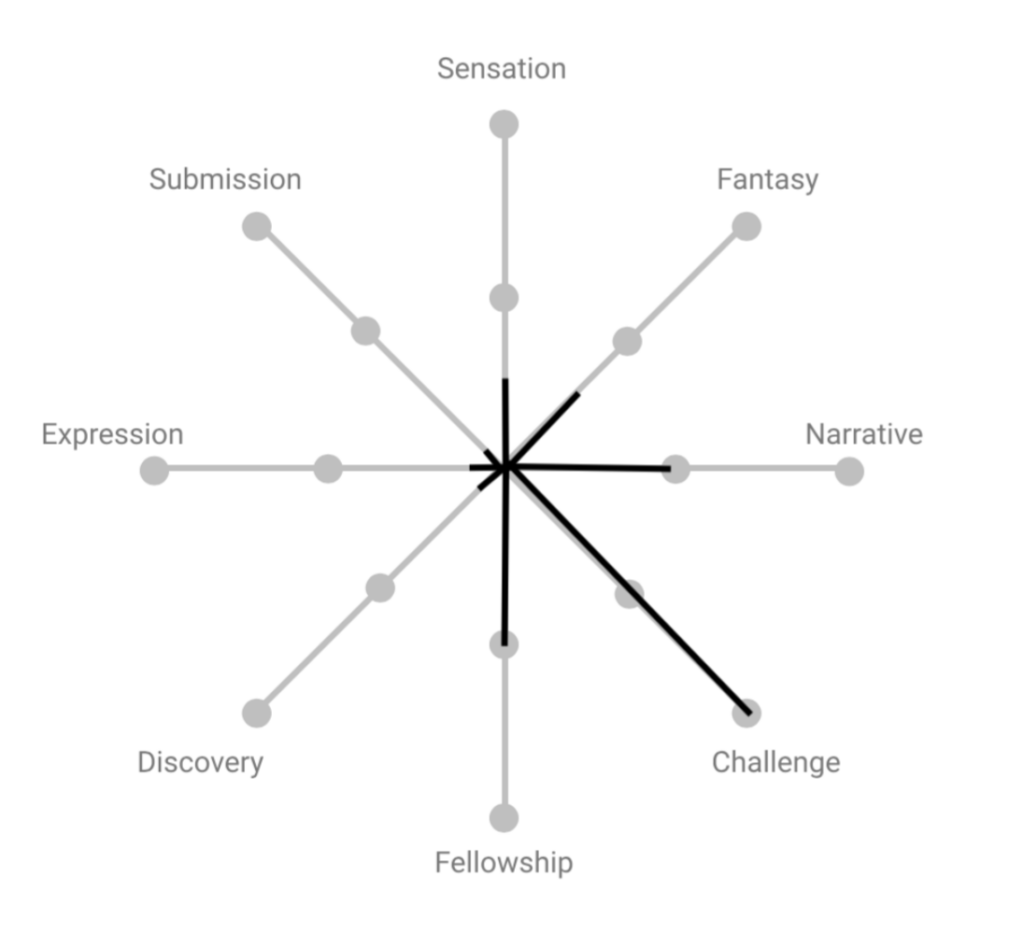
To converge on an idea, we came up with the following concept sketches:
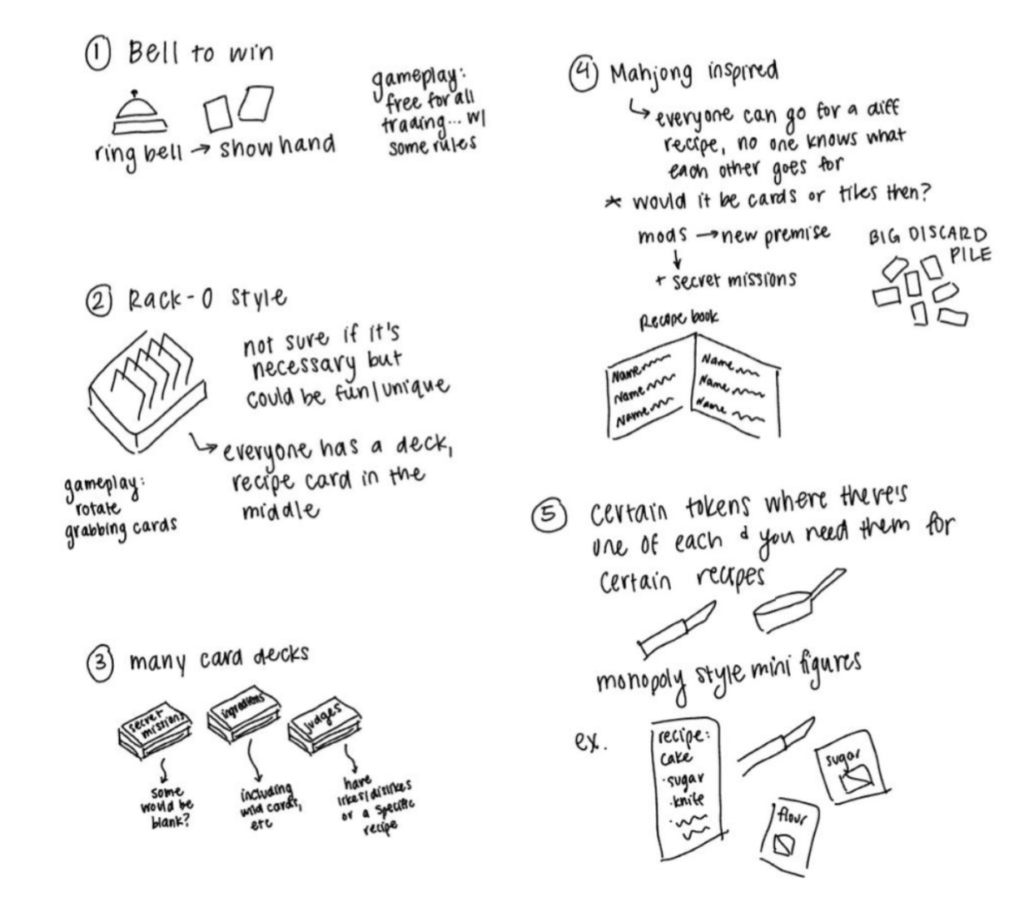
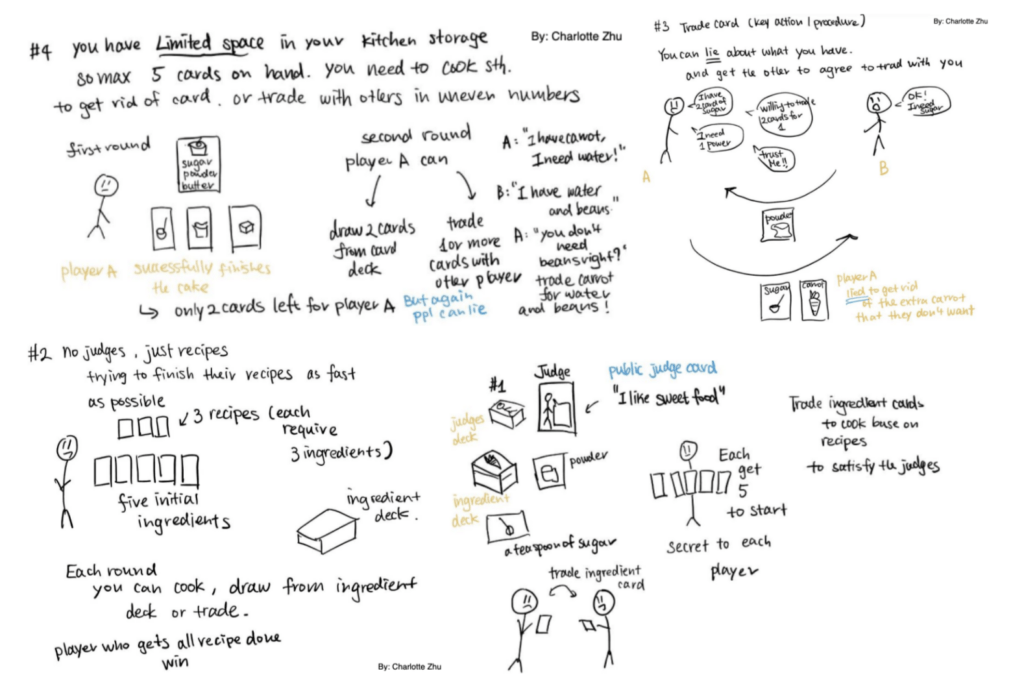
Testing and Iteration History
Playtest #1
Our group (4 designers) playtested using our low-fi prototype made of sticky notes.
Questions Asked:
- What game format makes sense?
- Should players rotate as judges or should there be judge cards?
- Will we create pre-formed recipes or will everyone come up with their own?
- How does the game end?
- How does one win?
| Changes Made | Rationale |
| Add judges | We added judges that had preferences towards certain ingredients. This meant that players could strategize about what to cook. |
| Ending the game: a player is “done cooking” during their turn and shows their hand, then everyone calculates points | With this ending, players may choose to hold onto a completed recipe and try to complete their secret mission or end the game and catch other players before they could complete their recipe. |
| Format: cards (no board) | A board or other mediums from our concept sketches were not necessary, as all information necessary was shown on cards. |
| Introduced the “marketplace” concept: free trading after each round | We felt our game was lacking fellowship, so this round incentivized people to trade cards. We decided that players were not required to be truthful in order to maintain the “sabotage” aspect of the game. |
Playtest #2
Four classmates playtested our game (moderator/notetaker: Paige and Charlotte). Our prototype was a mixture of sticky notes and printed cards.
Questions Asked:
- Do judge cards work well?
- Does the marketplace work?
| Changes Made | Rationale |
| Specified the number of each ingredient (enough to make exactly two of each recipe) | Players could not complete their recipes because the ingredient ratios were off. Also, players did not trade much in the marketplace. We realized that players would be incentivized to trade if they needed cards in each others hands to complete their own recipes. |
| Added 10+ event cards to the event card deck. Balances a few powerful events (change the judge entirely, change all your cards at hand, etc), with many less powerful events (+1 -1 ingredient on your hand, etc). | Players stopped drawing event cards because they felt too risky. |
| Display the recipe book as one page | Players said they wanted to see all recipes at once so that other players would not know when they were changing their recipe or which recipes they were looking at. |
| Clarified that each player should only go for one recipe. | One player tried to complete two recipes. Since we wanted the game to be fast paced, we decided to only allow players to recieve points for one. |
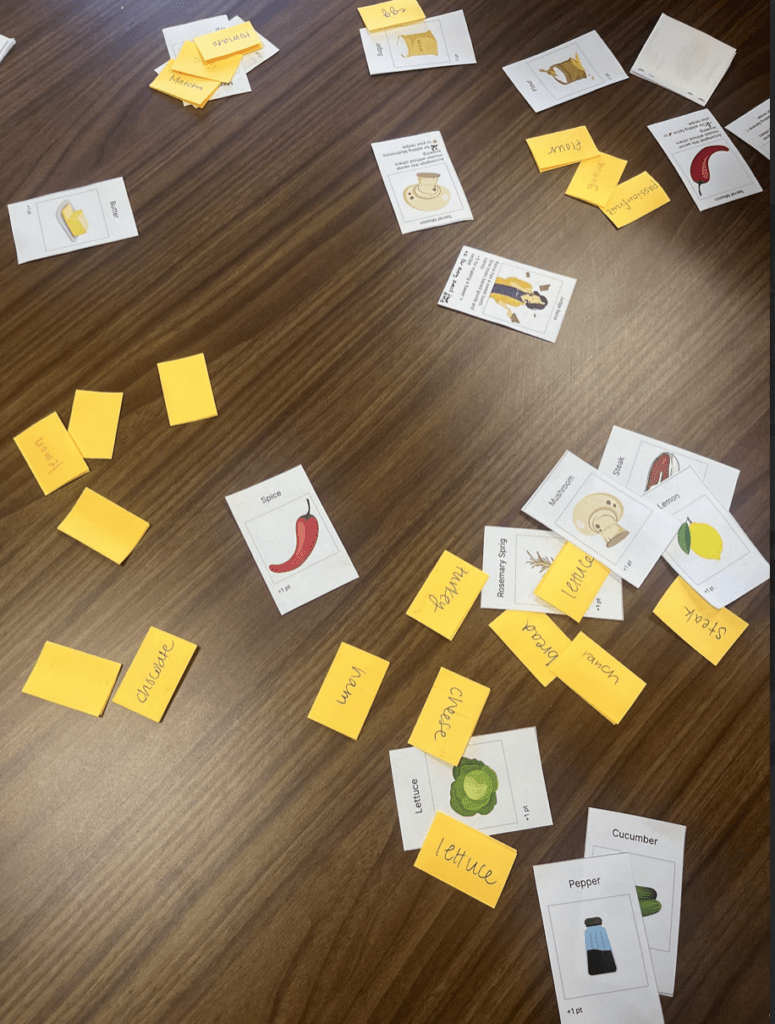

Playtest #3
Four classmates playtested our game (moderator/notetaker: Lucia and Hannah). Our prototype was all printed cards.
Questions Asked:
- Does limiting the ingredients increase social play?
- How should we structure the guessing of secret missions?
- Are people more inclined to grab event cards now that there are more positive ones?
- Did including more secret missions make it harder to guess the secret mission?
| Changes Made | Rationale |
| Added more positive events | When we had an equal amount or more bad events, players were very reluctant to draw from the event card deck. This happened when players initially drew very bad events and were intimidated to draw more. |
| Added more impactful events | Having crazy events incentivized players to draw from the event card deck because it made the gameplay more exciting. |
| Adding recipes to the cookbook | This made it harder to guess what recipe each player was making and made room for creativity and strategy. |
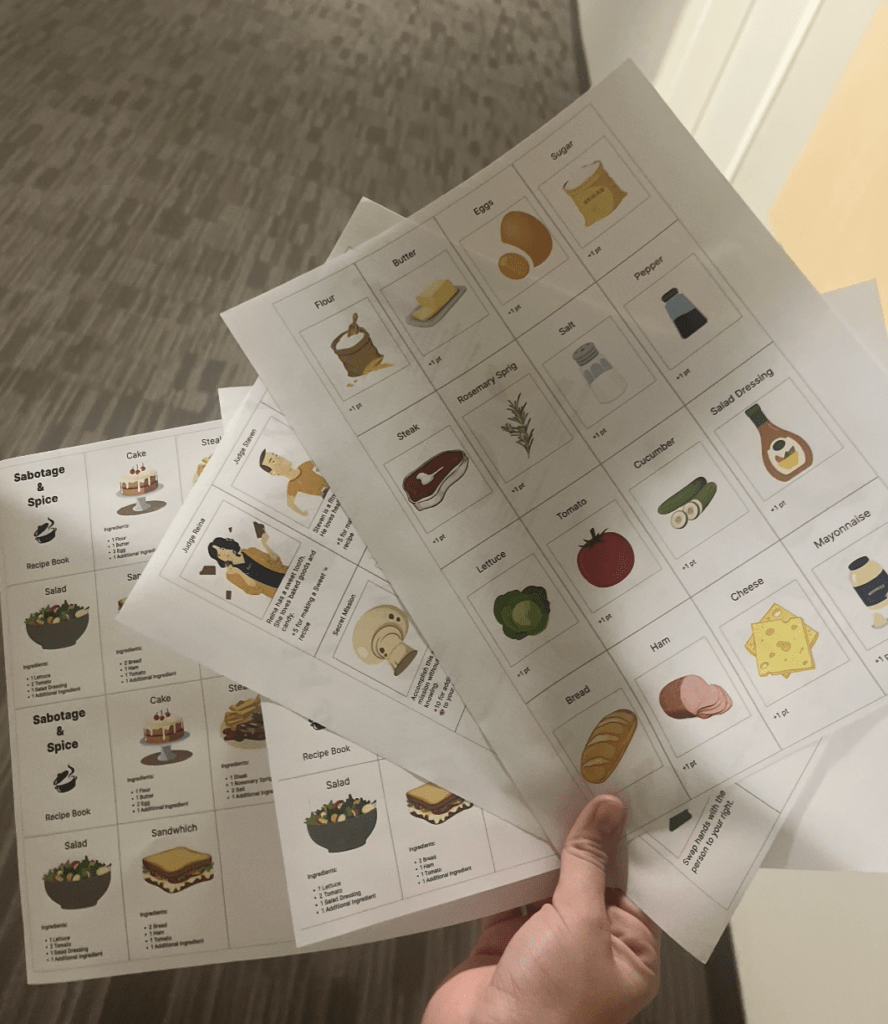
Playtest #4 and #5
Four classmates playtested our game (moderator/notetaker: Paige and Hannah). We had extra time and another four classmates playtested (moderator/notetaker: everyone). Our prototype was all printed cards with the new branding.
Questions Asked:
- Should we combine event cards and ingredient cards into one pile?
- How will our new marketplace work now that we made it less procedural?
| Changes Made | Rationale |
| Clarify and change the points system. – Extra points in your hand count against you – No extra points for missing ingredients | During the fourth playtest, players were very confused about the points system and it affected gameplay. One player had nearly 25 cards in his hand because the rules were unclear and he didn’t realize that would result in a large loss of points. We also realized we were double penalizing for missing ingredients. |
| Discard face up | Players discard face up to allow other players to strategize and notice what ingredients they don’t want. |
| Everyone gets to guess one secret mission with no penalty for incorrect guessing | Players were not guessing the secret missions because the point penalty for getting it wrong was too high. |
| Print enough cards to make three of each recipe. | We wanted more than 4 people to be able to play the game. This version allowed for 4 max. |
| Add a dummy guide | The dummy guide was meant to clarify any confusion over the point system. It also kept the point system less complicated because it was constrianed to the size of one card. |
| Allow more freedom in the marketplace. | Players can choose to trade or not to trade. Players may also trade two cards for one, give away a card, etc. We specified this in the rules. We made this change because the players traded in this way during the playtest, adding to the fellowship aesthetics. |
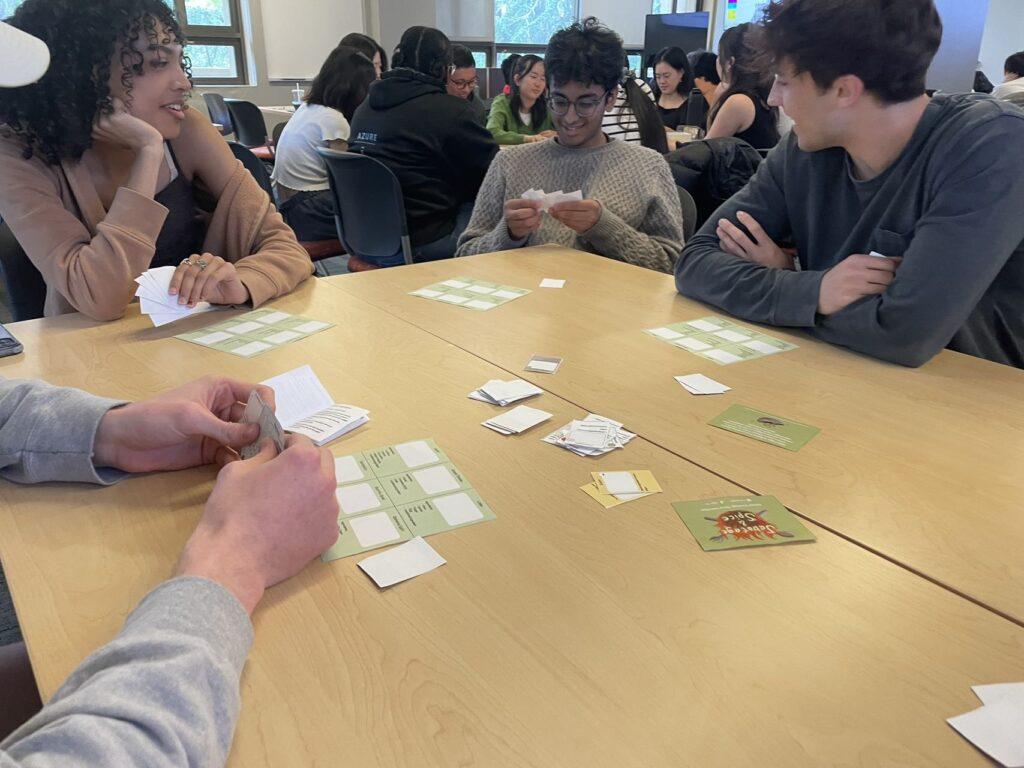
Evolution of Cards
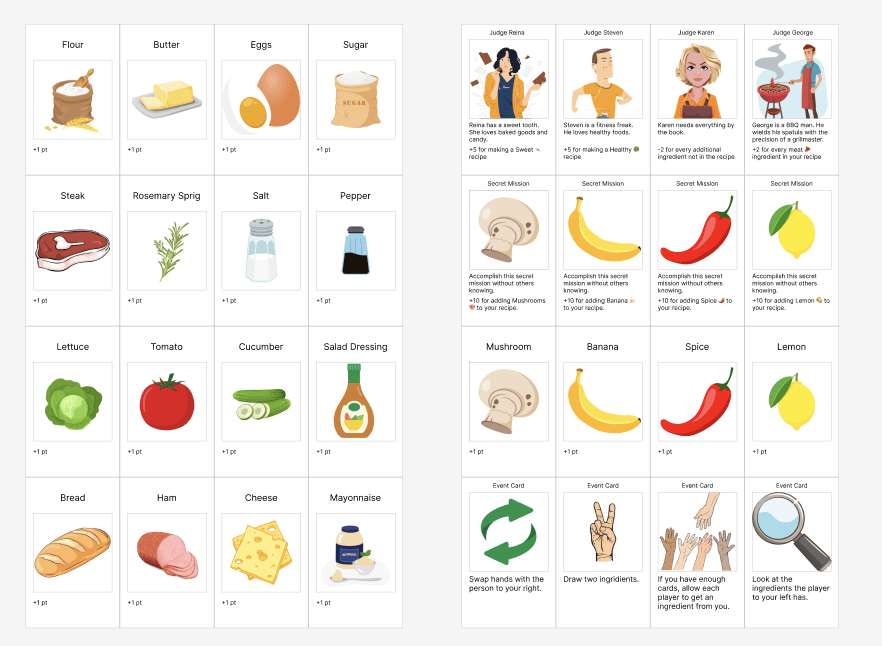
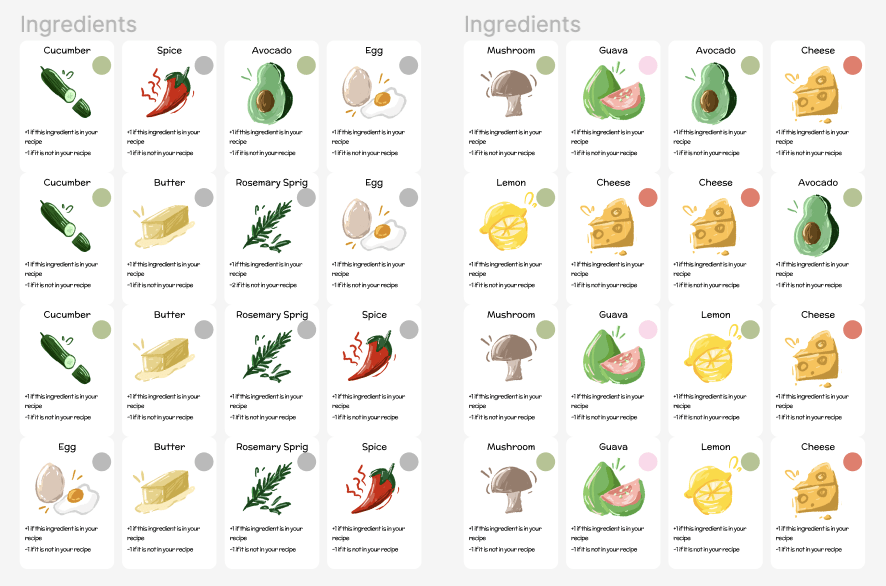
Final Prototype
Physical Version:
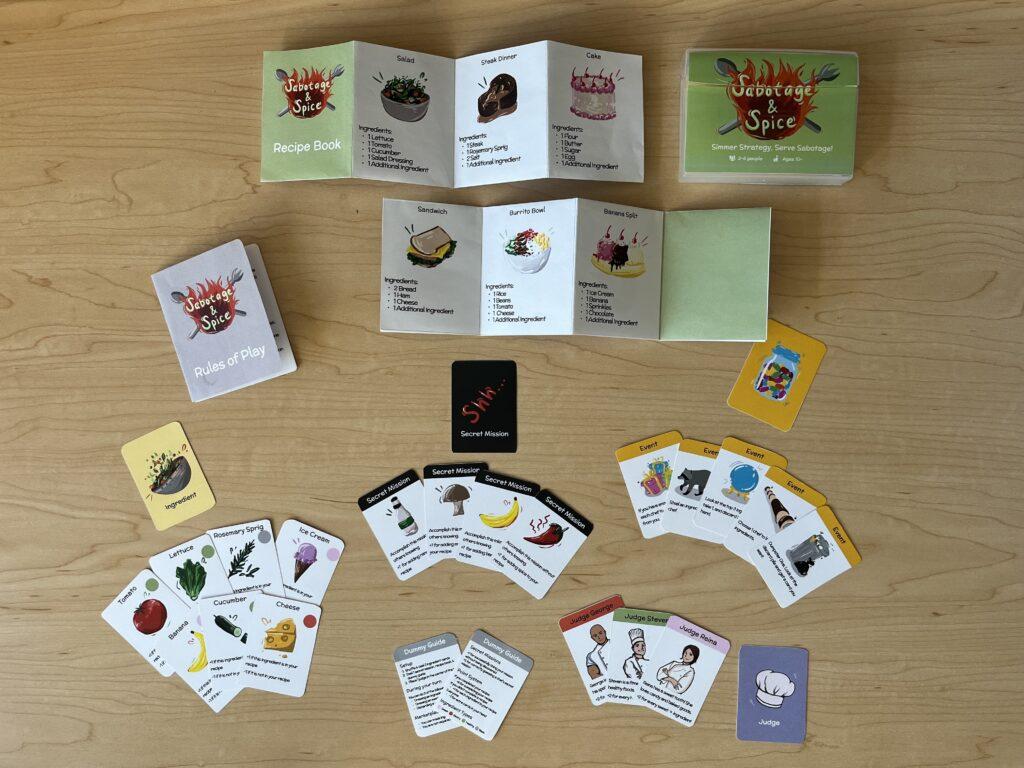
Video of Final Playtest
Video Details:
- Reading Rulebook – 0:00 to 7:08
- Gameplay – 7:08 to 26:59
- Totaling Points – 26:59 to 30:39
- Guessing Secret Missions – 30:39 to 33:24



